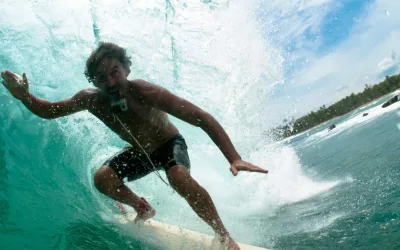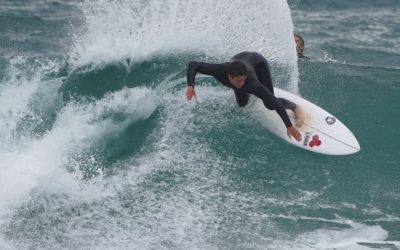At Peña Txuri Surf Eskola, we know that understanding waves is key to enjoying surfing and improving with each session. In this article, we will explain in a simple and clear way how waves are formed, what factors affect them, and what parts make them up. This way, when you’re in the water, you’ll be able to read the conditions better and make the most of every wave.
What is the Process of Wave Formation?
The formation of waves begins in the open sea when the wind blows over the surface of the water. This wind transfers its energy to the water, creating small ripples that, as they gain more energy and travel long distances, transform into the waves we see on the coast. The size and shape of these waves depend on several factors such as the wind’s strength and direction, how long it blows, and the distance over which the wind moves, also known as the “fetch.”
What Factors Affect Wave Formation?
The main factors affecting wave formation and their size include:
- Wind: The intensity and direction of the wind are essential. Strong winds generate larger waves, while lighter winds create smaller waves.
- Fetch: The larger the unobstructed distance over which the wind blows across the ocean, the bigger and better-formed the waves will be.
- Tides: Tides influence the height and behavior of waves when they reach the shore. During low tide, waves tend to be steeper and faster, while at high tide, they may be gentler and less pronounced.
- Seafloor: The shape of the seafloor, whether sand, rock, or coral, determines how waves break when they reach the coast. Waves tend to be smoother over sandy bottoms and more powerful over rocky or coral reefs.
What Are the Parts of a Wave?
To better understand how to surf a wave, it’s important to know its main parts:
- Crest: This is the top part of the wave, the highest point before it breaks. The most energy is concentrated here.
- Face of the wave: The sloped surface of the wave between the crest and the base, where surfers ride.
- Base: The lowest point of the wave, where the “take-off” happens, the moment when the surfer stands up on the board.
- Lip: The upper part that moves forward when the wave breaks. In some waves, the lip forms barrels, allowing surfers to ride inside the wave.
- Whitewater: This forms when the wave breaks and loses energy. It usually appears in the breaking zone near the shore.
Why Do Waves Break?
The formation of waves and their breaking are related to the water’s depth. When a wave approaches the coast and reaches shallower waters, the bottom of the wave slows down due to contact with the seafloor, while the upper part continues moving forward. This imbalance causes the wave to tilt forward and eventually break. Depending on the type of seafloor and the tide, waves can break more gently or aggressively.
What Types of Waves Are There for Surfing?
- Beach Break Waves: These break over sandy bottoms, making them safer and more predictable. They are ideal for beginners.
- Reef Break Waves: These break over rocky or coral bottoms, are usually more powerful and faster, perfect for experienced surfers.
- Point Break Waves: These break consistently over a rocky bottom, creating long and regular waves. They are highly valued for their quality.
What Waves Are Best for Beginners?
For those just starting, waves over sandy bottoms (beach breaks) are the most recommended. These waves are generally softer and safer, allowing beginners to learn without the risk of falling onto rocks or coral. At Peña Txuri Surf Eskola, we use these types of breaks so that our students can practice in a controlled and safe environment.
How Do We Teach Wave Formation at Peña Txuri Surf Eskola?
At Peña Txuri Surf Eskola, we know that understanding wave formation is fundamental to improving in surfing. We don’t just teach you how to ride waves; we teach you how to read and understand them. Our instructors will explain the basic concepts of waves, how they behave in different conditions, and how to make the most of them depending on your level. We use a clear and personalized methodology so that each student, from beginners to advanced levels, can progress safely and enjoyably.
Additionally, our team will guide you at all times so that you choose the best time to surf according to the day’s conditions, taking into account the tides, wind, and type of break.
Come Surf with Us!
If you want to truly learn how to surf, understand how waves are formed, and enjoy the ocean at its fullest, Peña Txuri Surf Eskola is your best choice. Our team of professionals will ensure that you understand the waves and can make the most of them, regardless of your level. Book your surf lesson with us and experience surfing at one of the best beaches in the Basque Country. We look forward to seeing you in the water!



